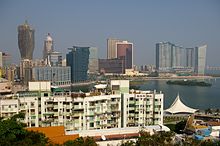Economy of Macau

|
|
| Currency | pataca (MOP) |
|---|---|
| calendar year | |
|
Trade organisations
|
WTO |
| Statistics | |
| GDP | US$51.8 billion (413.5 billion patacas, 2013) |
| GDP rank |
82nd (nominal) / 94th (PPP) |
|
GDP growth
|
11.9% (2013), -26.4% (Q2 2015 year-on-year) |
|
GDP per capita
|
US$88,700 (2013 est.) |
|
GDP by sector
|
services: 94.1%, industry: 5.9% (2014 est.) |
| 6% (2014 est.) | |
|
Population below poverty line
|
no data |
|
Labour force
|
367,800 (2013 est.) |
|
Labour force by occupation
|
wholesale and retail trade 13.3%, gambling 13.3%, restaurants and hotels 12.7%, construction 8.7%, public sector 6.7%, transport and communications 5.5%, manufacturing 4.3%, financial services 2.4%, other services and agriculture 33.2% (2010 est.) |
| Unemployment | 1.9% (2013 est.) |
|
Main industries
|
tourism, gambling, clothing, textiles, electronics, footwear, toys |
| External | |
| Exports | $1.137 billion (2013 est.) |
|
Export goods
|
clothing, textiles, footwear, toys, electronics, machinery and parts |
|
Main export partners
|
|
| Imports | $10.13 billion (2013 est.) |
|
Import goods
|
raw materials and semi-manufactured goods, consumer goods (foodstuffs, beverages, tobacco), capital goods, mineral fuels and oils |
|
Main import partners
|
|
| Public finances | |
| $0 (2013) | |
| Revenues | $16.95 billion (2012 est.) |
| Expenses | $6.934 billion (2012 est.) |
The economy of Macau has remained one of the most open in the world since its handover to China in 1999. Apparel exports and gambling-related tourism are mainstays of the economy. Since Macau has little arable land and few natural resources, it depends on mainland China for most of its food, fresh water, and energy imports. Japan and Hong Kong are the main suppliers of raw materials and capital goods. Although Macau was hit hard by the 1997–98 Asian financial crisis and the global downturn in 2001, its economy grew approximately 13.1% annually on average between 2001 and 2006. Macau is a full Member of the World Trade Organization.Public Security has greatly improved after handover to People's Republic of China. With the tax revenue from the profitable gambling industry, the Macau government is able to introduce the social welfare program of 15 years of free education to all Macau citizens. In 2015, Macau's economy saw a sharp decrease (-26.4% year-on-year in Q2 2015) due to the reduced spending by visitors from Mainland China. [1]
During the first three quarters of 2007, Macau registered year-on-year GDP increases of 31.4%. A rapid rise in the number of mainland visitors due to China's easing of travel restrictions, increased public works expenditures, and significant investment inflows associated with the liberalisation of Macau's gaming industry drove the five-year recovery. The budget also returned to surplus after 2002 because of the surge in visitors from China and a hike in taxes on gambling profits, which generated about 70% of government revenue. The Hong Kong dollar is itself a reserve currency for the Macanese pataca, which is pegged at the official rate of around 1 Hong Kong dollar to 1.03 Macanese pataca.
Macau was a barren fishing village with a population of about 400 before the Portuguese arrived in the 16th century, during the Age of Discovery. In 1535, the Portuguese traders obtained by bribing the right to anchor ships in Macau harbours and engage in trading activities. Portuguese and Chinese merchants flocked to Macau, and it quickly became an important regional trading center in Portugal's lucrative trade along three major routes: Macau-Malacca-Goa-Lisbon, Guangzhou-Macau-Nagasaki and Macau-Manila-Mexico. However, with the decline of Portugal as a world power in the 17th and 18th centuries, the trading routes were challenged by other powers such as the Dutch and the British. After China ceded Hong Kong to the British in 1842, Macau's position as a major regional trading center declined further still because larger ships were drawn to the deep water port of Victoria Harbour. In an attempt to reverse the decline, from 1848 to the early 1870s Macau engaged in the infamous trade of coolies (slave labourers) as a transit port, shipping locals from southern China to Cuba, Peru, and other South American ports to work on plantations or in mines.
...
Wikipedia
